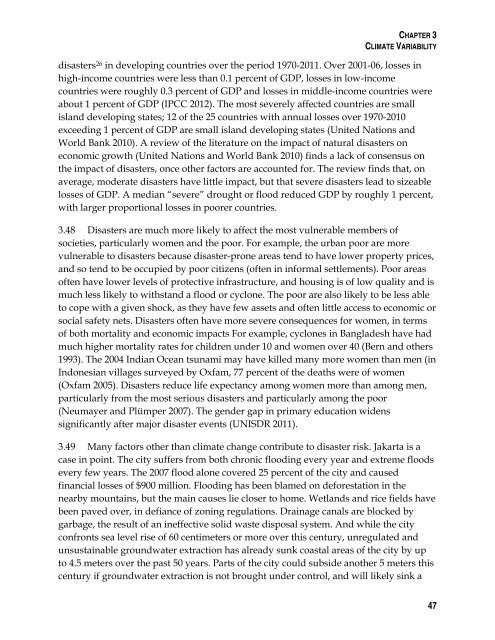Adapting to Climate Change: Assessing the World Bank Group ...
Adapting to Climate Change: Assessing the World Bank Group ...
Adapting to Climate Change: Assessing the World Bank Group ...
You also want an ePaper? Increase the reach of your titles
YUMPU automatically turns print PDFs into web optimized ePapers that Google loves.
CHAPTER 3CLIMATE VARIABILITYdisasters 26 in developing countries over <strong>the</strong> period 1970-2011. Over 2001-06, losses inhigh-income countries were less than 0.1 percent of GDP, losses in low-incomecountries were roughly 0.3 percent of GDP and losses in middle-income countries wereabout 1 percent of GDP (IPCC 2012). The most severely affected countries are smallisland developing states; 12 of <strong>the</strong> 25 countries with annual losses over 1970-2010exceeding 1 percent of GDP are small island developing states (United Nations and<strong>World</strong> <strong>Bank</strong> 2010). A review of <strong>the</strong> literature on <strong>the</strong> impact of natural disasters oneconomic growth (United Nations and <strong>World</strong> <strong>Bank</strong> 2010) finds a lack of consensus on<strong>the</strong> impact of disasters, once o<strong>the</strong>r fac<strong>to</strong>rs are accounted for. The review finds that, onaverage, moderate disasters have little impact, but that severe disasters lead <strong>to</strong> sizeablelosses of GDP. A median “severe” drought or flood reduced GDP by roughly 1 percent,with larger proportional losses in poorer countries.3.48 Disasters are much more likely <strong>to</strong> affect <strong>the</strong> most vulnerable members ofsocieties, particularly women and <strong>the</strong> poor. For example, <strong>the</strong> urban poor are morevulnerable <strong>to</strong> disasters because disaster-prone areas tend <strong>to</strong> have lower property prices,and so tend <strong>to</strong> be occupied by poor citizens (often in informal settlements). Poor areasoften have lower levels of protective infrastructure, and housing is of low quality and ismuch less likely <strong>to</strong> withstand a flood or cyclone. The poor are also likely <strong>to</strong> be less able<strong>to</strong> cope with a given shock, as <strong>the</strong>y have few assets and often little access <strong>to</strong> economic orsocial safety nets. Disasters often have more severe consequences for women, in termsof both mortality and economic impacts For example, cyclones in Bangladesh have hadmuch higher mortality rates for children under 10 and women over 40 (Bern and o<strong>the</strong>rs1993). The 2004 Indian Ocean tsunami may have killed many more women than men (inIndonesian villages surveyed by Oxfam, 77 percent of <strong>the</strong> deaths were of women(Oxfam 2005). Disasters reduce life expectancy among women more than among men,particularly from <strong>the</strong> most serious disasters and particularly among <strong>the</strong> poor(Neumayer and Plümper 2007). The gender gap in primary education widenssignificantly after major disaster events (UNISDR 2011).3.49 Many fac<strong>to</strong>rs o<strong>the</strong>r than climate change contribute <strong>to</strong> disaster risk. Jakarta is acase in point. The city suffers from both chronic flooding every year and extreme floodsevery few years. The 2007 flood alone covered 25 percent of <strong>the</strong> city and causedfinancial losses of $900 million. Flooding has been blamed on deforestation in <strong>the</strong>nearby mountains, but <strong>the</strong> main causes lie closer <strong>to</strong> home. Wetlands and rice fields havebeen paved over, in defiance of zoning regulations. Drainage canals are blocked bygarbage, <strong>the</strong> result of an ineffective solid waste disposal system. And while <strong>the</strong> cityconfronts sea level rise of 60 centimeters or more over this century, unregulated andunsustainable groundwater extraction has already sunk coastal areas of <strong>the</strong> city by up<strong>to</strong> 4.5 meters over <strong>the</strong> past 50 years. Parts of <strong>the</strong> city could subside ano<strong>the</strong>r 5 meters thiscentury if groundwater extraction is not brought under control, and will likely sink a47

















